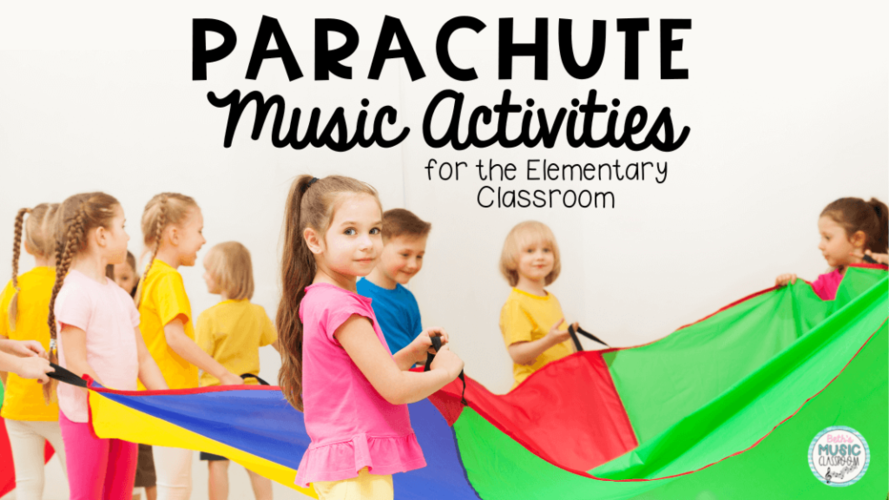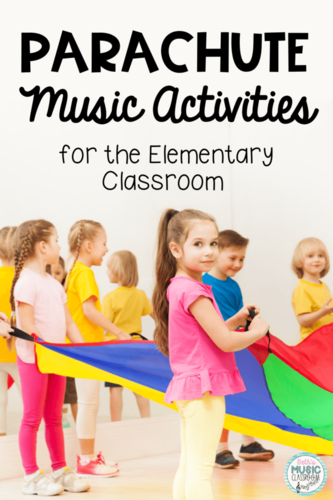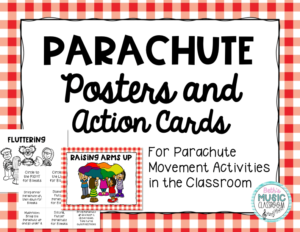Parachute Music Activities

Parachute Music Activities
When my students come in and hear that we are using the parachute in music class, they are just ecstatic! I love adding some parachute music activities into a lesson because each of my classes thoroughly enjoy it! In this post, we’ll look at the benefits of using a parachute, some tips on getting your students ready, and also some examples of parachute activities.
Benefits of Parachute Music Activities
First, let’s look at some benefits of using parachute music activities in the elementary classroom. For one thing, students will surely have so much fun with it. Parachutes are engaging, exciting, and encouraging for your students. They can be used as an incentive or a teamwork activity. Also, adding parachute games to your lesson requires little to no prep. Not only those benefits, but parachute activities and games also help students develop rhythm, form, tempo, and other elements of music.
Parachute Music Preparation
Before we begin, if you don’t have a classroom parachute, I would definitely suggest purchasing one if you’re able. They seem to have come down in price over the last 6-8 years. I found mine during the summer at Aldi for under $15. Here’s another good quality parachute option to purchase on Amazon (an affiliate link: you pay the same, I get a small commission).
Now, if I have you excited and hooked on parachutes, then read on for some tips on using them in your classroom. You will want to do some initial preparation with students before you actually hand them the parachute. This foundation will go a long way with your other parachute activities.
For example, one of my first “rules” is about how to hold the parachute. I first model it, showing how I grab it on the colorful part with my thumbs underneath, like bicycle handles (my preference). With a full class of 23-26 students, not every student will be able to grab onto a handle, so this is important. Then, we discuss different ways or directions we can move:
- Up vs. down
- In vs. out
- Right vs.left
- Moving the parachute vs. holding it still
- Standing still vs. swapping places
- “Baby waves” vs. “tsunami”
Finally, we discuss some tips on how to move or perform each of those actions above. I like to explain how they should bring their hands up or down – for example using words like “slow and smooth.” Otherwise, they often tend to just bring their arms straight up/down.
Like you saw in the list above, I always use words like “baby waves” when we ripple the parachute (to avoid having a tsunami – LOL). We discuss words like force, strength, power, direction as we prepare for parachute songs and games.
Choosing Music and Movement for Parachute Activities
After the initial introduction, explanation, and rules of using a parachute, now we are ready to begin an actual parachute song and game! So let’s take a look at some different parachute music you could use and some parachute activities for all grade levels.
First, you can choose a well-known song from a composer lesson and add a parachute activity. I find it to be just the active break that my students need in the middle of listening to a composer biography. Don’t be afraid to choose one of your favorite composer pieces and write some simple parachute routine for it. Think about the form and dynamics, and match motions for each section, depending on how loud or soft it is. For example, a softer section may be better with ripples than up/down motions.
Here’s a list of well-known pieces that I have used with a parachute activity with my students:
- “Eine kleine Nachtmusik” (K. 525) – W.A. Mozart
- “March” from The Nutcracker – Tchaikovsky
- “Spring” from The Four Seasons – Vivaldi
- “William Tell Overture” – Rossini
- “Olympic Fanfare and Theme” – Williams
- “The Syncopated Clock” – Anderson
- “Viennese Musical Clock” – Kodaly
- “Fossils” from The Carnival of the Animals – Saint-Saens
- “Kangaroos” from The Carnival of the Animals – Saint-Saens
- “Rondo alla Turca” – W.A. Mozart
- “The Entertainer” – Joplin
- Symphony No. 9 – Beethoven
- “Ballet of the Unhatched Chicks” – Mussorgsky
These parachute routines could be as simple or as complicated as you wish. Think of your students and what they can handle. For example, I have used “Fossils” from The Carnival of the Animals in the past with several grades. With kindergarten, I choose one motion for each section of this rondo: A – ripple; B – walk in a circle; C – up and down.
But with 2nd and 3rd grade, they are able to do something slightly more difficult: A – up, down, ripple; B – walk right for 8 beats, walk left for 8 beats, walk into center for 4 beats (to make a mushroom), walk back to full circle for 4 beats, walk into center for 4 beats (to make a mushroom), walk back to full circle for 4 beats; C – ripple and walk in circle.
Not only with composer selections, but you can also use children’s songs or pop songs for a parachute activity. Students of all ages love parachute games! Here’s a few suggestions:
If you’re interested in adding some parachute music activities to your lessons, I encourage you to try creating some of your own, using some here, or searching YouTube for lots more. To help you with this, I have a free set of parachute movement posters and cards for you to use in your classroom! Just click here to snatch them!
If you get a chance to try some of these parachute activities in your classroom, I’d absolutely love to hear how it went! You can always leave a comment below, email me (beth@bethsmusicclassroom.com), or send me a DM on Instagram @bethsmusicclassroom.
If you’re looking for some more elementary music activities, check out this post on using scarves in the elementary music room.

Parachute Music Activities




These are great! I love the open-ended nature of your suggestions, which means I can’t really mess it up.
When you have the kids switch places, what does that look like?
My students stand on a round carpet with several different color squares around the outside. Sometimes, I say to go up and down with the parachute, but for this, I say go up and stay up. Then I call a color, and anyone on that square color goes under the parachute and switches places. They’re basically finding any new open square to stand. Then, we’ll repeat this giving everyone a chance. I hope this helps!